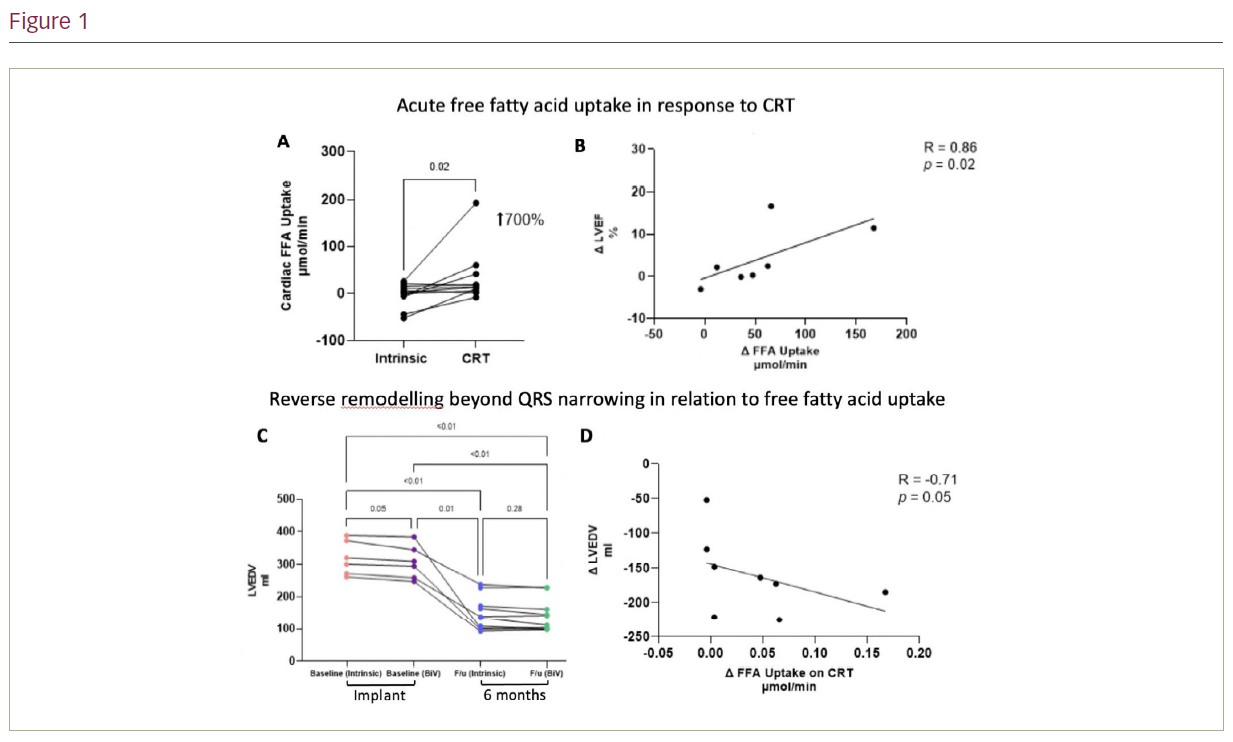Introduction: The failing heart is thought to be metabolically inflexible, and oxygen limited, shifting from free fatty acid (FFA) oxidation towards glucose metabolism. Whilst glucose metabolism is more oxygen efficient, fatty acid (FA) metabolism generates more adenosine triphosphate (ATP) per mole of substrate. Cardiac resynchronisation therapy (CRT) acutely improves cardiac haemodynamics in patients with severe heart failure and a left bundle branch block, and subsequently induces long-term reverse remodelling by a process that is unpredictable and poorly understood. We tested the hypothesis that CRT alters metabolic substrate usage, and that its ability to do so correlates with functional improvement and subsequent reverse remodelling.
Methods: Participants with non-ischaemic cardiomyopathy were started on a hyperinsulinaemic euglycaemic clamp (insulin/dextrose) prior to CRT implant. During implant, measurements of left ventricular (LV) contractility (using a pressure-volume loop catheter), coronary flow (using a Doppler guide wire) and paired arterio-venous blood samples (from the left main stem and coronary sinus) were obtained with and without optimised CRT. All measurements were then repeated on an FFA infusion (20% IntralipidTM). Participants had cardiac magnetic resonance imaging (MRI 1.5 T) at 6 months, with and without biventricular pacing in MRI-safe mode, to assess reverse remodelling.
Results: Twelve participants were recruited (7 male, median age 64 [IQR 60–71]) all with left bundle branch block (QRS duration 169 [162–183] ms) and severely impaired LV ejection fraction (29% [25–31]). Measures of LV contractility (work and dP/dtmax) were significantly improved by CRT on both infusions, without an increase in myocardial oxygen demand, resulting in improvement in cardiac efficiency (insulin/dextrose: +7.9%, p=0.02; FFA: +31%, p=0.02). Metabolic flexibility was therefore retained. On insulin/dextrose, CRT increased cardiac FFA uptake within 2 minutes of pacing (Figure 1A), which positively correlated with improvement in LV ejection fraction (LVEF, Figure 1B). When FFA uptake was maximised on an FFA infusion, CRT increased ketone uptake, which positively correlated with improvement in cardiac work (R=0.55, p=0.04). At all points, the heart was a net lactate consumer rather than producer, implying that oxygen supply was not limited. Substantial reverse remodelling was observed at 6 months following implant with significant improvements in ejection fraction (40% [33–50], p<0.01) and LV end-diastolic volume (LVEDV), beyond that seen with acute reduction in QRS duration with biventricular pacing (Figure 1C). Reverse remodelling strongly correlated with acute changes in FFA (Figure 1D) and ketone uptake (R=-0.79, p=0.05) in response to CRT, but not the degree of shortening in QRS duration at implant (p=0.24).
Conclusion: CRT improves cardiac efficiency and whilst acute narrowing of QRS duration may be responsible for initiating reverse remodelling, by 6 months significant structural changes have occurred beyond that achievable by QRS narrowing alone. CRT reverses the metabolic phenotype of heart failure towards more physiological lipid-based metabolism and reverse remodelling is strongly correlated with the ability of the heart to acutely increase FFA and ketone uptake. Therapy promoting lipid metabolism may therefore be a useful treatment to promote reverse remodelling in non-ischaemic cardiomyopathy. ❑








